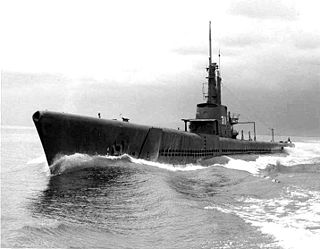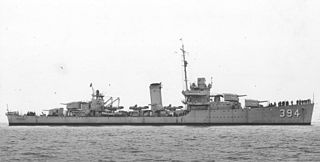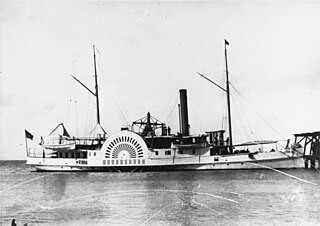
USS Cochino (SS-345) was a Balao-class submarine in service with the United States Navy from 1945 to 1949. She sank after a battery explosion off Norway, on 26 August 1949. Cochino was named for the cochino, a triggerfish found in the Atlantic.

USS Volador (SS-490), a Tench-class submarine, was the second ship of the United States Navy to be named for the volador.

USS Archerfish (SS/AGSS-311) was a Balao-class submarine. She was the first ship of the United States Navy to be named for the archerfish. Archerfish is best known for sinking the Japanese aircraft carrier Shinano in November 1944, the largest warship ever sunk by a submarine. For this achievement, she received a Presidential Unit Citation after World War II.

USS Cutlass (SS-478), is a Tench-class submarine now in the service of the Republic of China Navy. She was the only ship of the United States Navy to be named for the cutlassfish, a long, thin fish found widely along the coasts of the United States and in the West Indies. Her keel was laid down by the Portsmouth Navy Yard on 10 July 1944. She was launched on 5 November 1944 sponsored by Mrs. R. E. Kintner, and commissioned on 17 March 1945 with Commander Herbert L. Jukes in command.

USS Howard (DD–179), (DMS-7) was a Wickes-class destroyer in the United States Navy during World War II. She was named for Charles W. Howard, who was killed in the American Civil War aboard USS New Ironsides.

USS Stansbury (DD–180) was a Wickes-class destroyer in the United States Navy during World War II.

USS Guavina (SS/SSO/AGSS/AOSS-362), a Gato-class submarine, was a ship of the United States Navy named for the guavina, a fish which may reach a length of 2 feet (0.6 m) indigenous to the West Indies and the Atlantic coasts of Central America and Mexico.

USS Sea Cat (SS/AGSS-399), a Balao-class submarine, was a ship of the United States Navy named for a shortened form of sea catfish, a marine fish of little food value found off the southeastern coast of the United States commissioned on 16 May 1944, with Commander Rob Roy McGregor in command. During World War II Sea Cat operated within the Pacific theatre, conducting four war patrols in wolf packs accounting for up to 17400 tons in the form of three cargo ships and an enemy vessel. Sea Cat earned three battle stars for her World War II service.

USS Pomfret (SS-391), a Balao-class submarine, was a ship of the United States Navy named for the pomfret, a fish of the seabream family which is a powerful and speedy swimmer, capable of operating at great depths.

USS K-5 (SS-36) was a K-class submarine of the United States Navy. Her keel was laid down by the Fore River Shipbuilding Company in Quincy, Massachusetts, under a subcontract from the Electric Boat Company of Groton, Connecticut. She was launched on 17 March 1914 sponsored by Mrs. Warren G. Child, and commissioned on 22 August.

USS K-6 (SS-37) was a K-class submarine of the United States Navy. Her keel was laid down by the Fore River Shipbuilding Company in Quincy, Massachusetts, under a subcontract from the Electric Boat Company of Groton, Connecticut. She was launched on 26 March 1914, sponsored by Mrs. Thomas Gaines Roberts, and commissioned on 9 September at Boston, Massachusetts.

USS K-7 (SS-34) was a K-class submarine built for the United States Navy during the 1910s.

USS Dahlgren (DD-187/AG-91) was a Clemson-class destroyer which served in the United States Navy during World War II. Entering service in 1920, the ship had a brief active life before being placed in reserve in 1922. Reactivated in 1932, Dahlgren remained in service mainly as a test ship until 1945. She was sold for scrapping in 1946. She was named for Rear Admiral John A. Dahlgren (1809–1870), and was the second ship of three which served in the US Navy to receive the name.

USS Wright (AZ-1/AV-1) was a one-of-a-kind auxiliary ship in the United States Navy, named for aviation pioneer Orville Wright. Originally built as a kite balloon tender, she was converted into a seaplane tender after kite balloons were no longer used.

The third USS Decatur (DD-341) was a Clemson-class destroyer in the United States Navy following World War I. She was named for Stephen Decatur.

The first USS Noa (DD-343/APD-24) was a Clemson-class destroyer in the United States Navy following World War I. She was named for Midshipman Loveman Noa. At the beginning of World War II she was converted to a High-speed transport and redesignated APD-24.

The second USS Sampson (DD-394) was a Somers-class destroyer in the United States Navy. She was named of William Thomas Sampson a rear admiral known for his victory in the Battle of Santiago de Cuba during the Spanish–American War.

USRC Windom was a revenue cutter of the United States Revenue Cutter Service and United States Coast Guard that served from 1896 to 1930. She was named for William Windom, the 33rd and 39th United States Secretary of the Treasury. She served during the Spanish–American War with the United States Navy. Windom was recommissioned as USCGC Comanche in 1915 and again served with the Navy as USS Comanche during World War I.

USS Niobrara (AO-72) was a T3 Kennebec-class oiler constructed for the United States Navy during World War II. She was the only U.S. Navy ship named for the Niobrara River in Nebraska.

USS Delaware was a steamer acquired by the Union Navy for use during the American Civil War. She had a very active naval career as a gunboat for over three years, and after the war served as a revenue cutter for over 37 years. The steamer was sold to the private sector in 1903, and disappeared from shipping registers in 1919.





















